Overall Trends
- Construction of green buildings is an effective tool for increasing the sustainability of the living environment.
- Green building is developing in many directions.
- Innovative solutions for buildings with low energy consumption are actively developed and introduced into modern practice. The elements of “green” buildings – green roofs and green facades – are constantly being improved.
The definition of “green building” does not just characterize a particular type of structure or the use of a certain set of architectural techniques in its construction – this concept implies a complex system of specially developed principles on the basis of which both the construction and operation of the building are carried out (Yilmaz and Bakis, 2015).
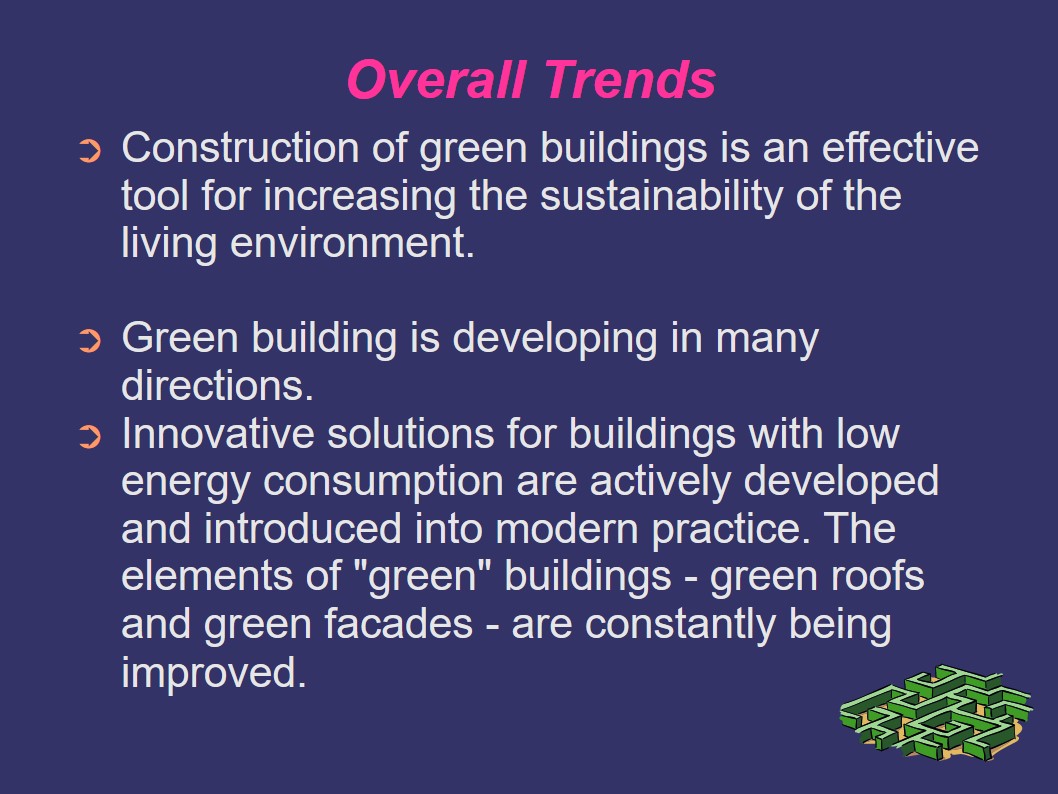
Green Materials and Technology
- Any measures that are aimed at preserving the environment can be referred to as “green” technologies used in construction.
However, the main and most important thing is to reduce energy consumption in order to save natural resources and minimize the amount of harmful substances impacting the environment, while maintaining warmth and comfort in the house (Dykstra, 2016).
- Several meanings are put into the phrase “green” building materials.
- They can be conditionally divided into two large subgroups: organic and energy efficient.
- There are two main requirements for “green” organic materials. First, it must be recycled and reusable materials.
- The second parameter is environmental friendliness.
- “Green” brick:
- Today, the use of green bricks has become such a popular building technology that they have almost completely replaced traditional materials.
- Green bricks are made from recycled materials and are very light in weight and have improved insulating properties.
Innovative materials and technologies are the most important foundation for green building. Changes in the development and production of building materials are already fundamentally changing the construction industry today. State-of-the-art materials and solutions make it possible to achieve high levels of energy saving, help to reduce the cost of the object’s life cycle and generally lead to a more comfortable and healthy environment.
At LEED headquarters, the floor is made of crushed concrete, like marble chips, and wood that has been on the river bed for over 100 years. It was picked up, dried and used in decoration (Dhir et al., 2019).
Many manufacturers fit under the term “green” all materials made from natural, “environmentally friendly” raw materials. But in the classical sense, “green” building materials are materials made from renewable natural (that is, organic) raw materials and, with “zero”, or minimal, carbon dioxide emissions during their manufacture (Kibert, 2016; Magwood, 2017).
The most popular material that meets these criteria is wood, its range of applications is quite wide. The same applies to other popular “green” materials – straw and reeds, hemp, cellulose and cotton insulation.
The problem with organic materials is that they are fire hazardous, which means that during the construction process they must be treated with chemical agents, which neutralizes environmental friendliness. For example, adding cement to wood reduces the environmental properties of the final material, but it also increases fire resistance.
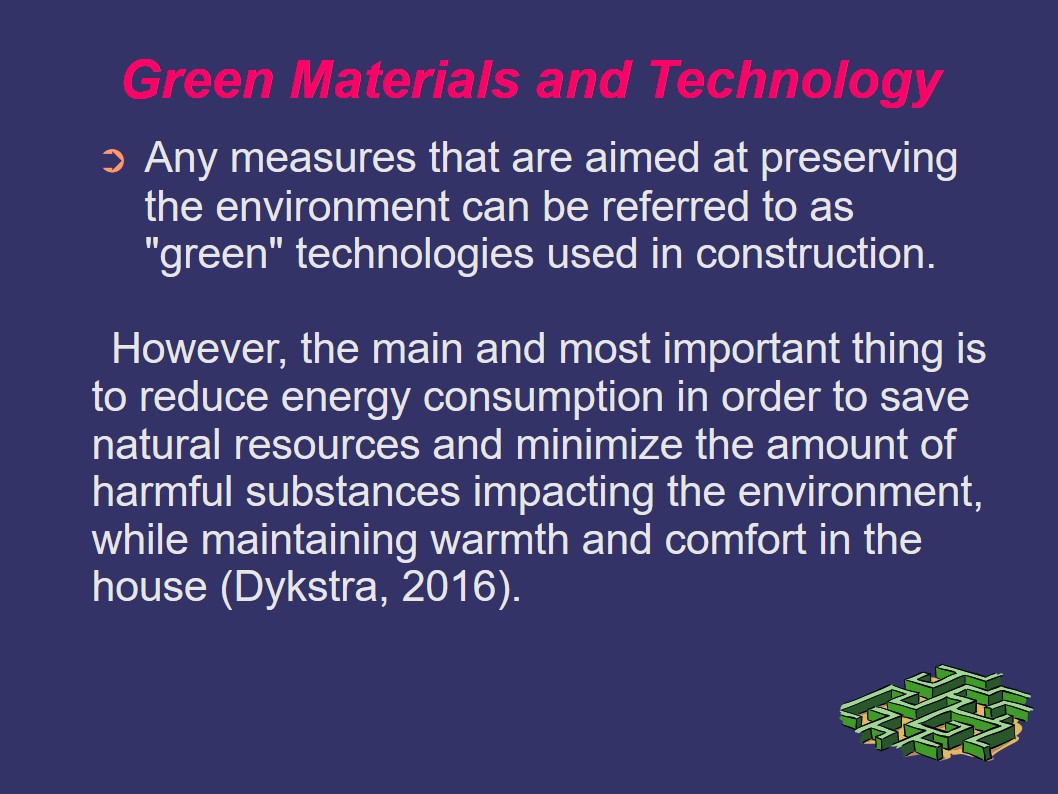


Arbolite in Green Construction
A very promising new material in this respect is arbolite – structural blocks made of sawdust and cement. The use of cement significantly increased the fire safety of the material and expanded the possibilities of its use in civil mass construction.
A wood block, or, rather, wood concrete block, contains up to 85-90 percent of wood waste. It also depends on the brand. Thanks to this, such blocks are rightfully considered one of the most environmentally friendly building materials. It is essentially a wood in concrete. The combination of these ingredients gives strong effect. Thermal and sound insulation of wood concrete blocks surpasses brick by almost 4-5 times, and expanded clay concrete – 2-3 times.
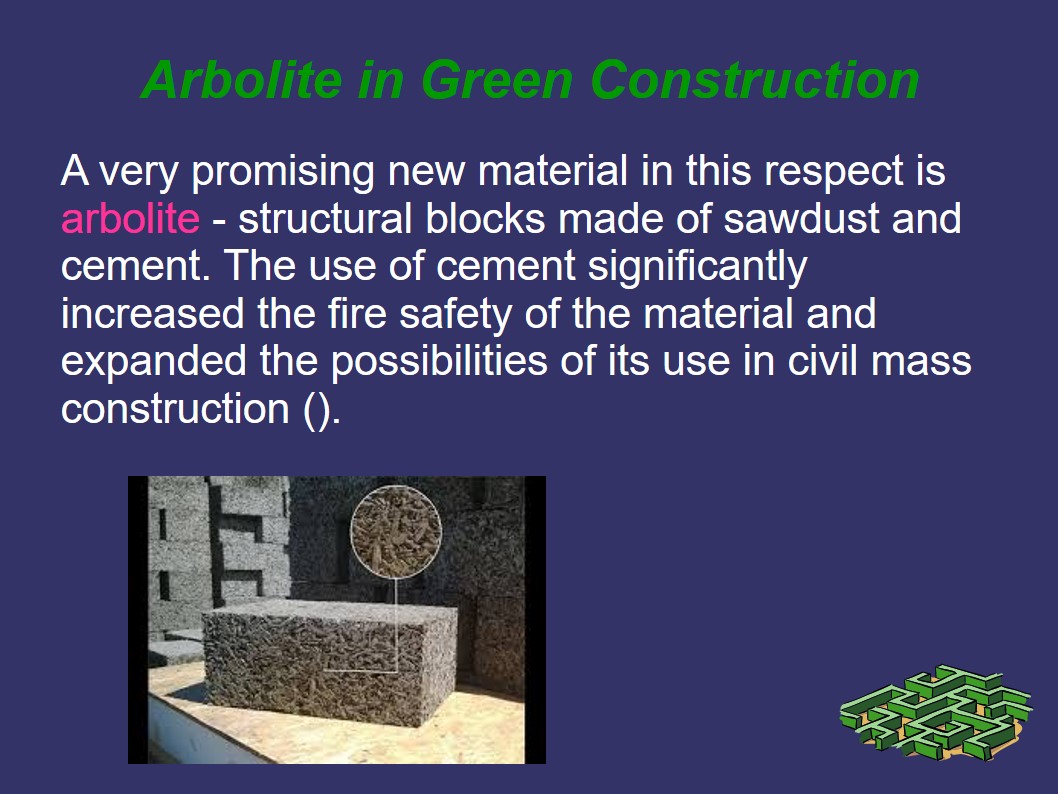
Arbolite Properties
Arbolite is very heat-absorbing – when heated, it absorbs heat, and when cooled, it gives off. Due to this property, the indoor microclimate is relatively stable during the day and night.
In a wood concrete room, when heated, the surrounding air will first warm up, and then only the walls. The heat capacity of wood concrete panels and blocks is about 2.3 kJ / kgK. This is higher than the air index (Dhir et al., 2019).
The dimensions of the standard block are 500 x 250 x 300 millimeters. The weight of 1 square meter of an arbolite wall does not exceed 200 kilograms, with a wall thickness of only 30 centimeters (Subramaniam, Subasinghe, and Fonseka, 2015).
Thanks to this mass, the foundation can be made lightweight. Moreover, important ones are such characteristics as a fairly high limit of strength – its ultimate strength in bending and increased resistance to shock loads, frost resistance (F25 – F50), non-susceptibility to the influence of rot, bacteria, rodents (Han, Zhang, and Ou, 2017).
Thanks to these characteristics, wood concrete has found wide application in construction in the northern regions.
Wood concrete houses are practically never damp. The walls “breathe,” air exchange with the environment is not disturbed. The fire hazard of such buildings is very low, even despite the high content of organic components. 0.8 – 1.5 hours – this is an indicator of the fire resistance of wood concrete buildings (De Luca, Carbone, and Nagy, 2017).
Application in construction:
Wood concrete grades: 5, 10, 15, 25, 35 and 50. Heat-insulating (up to 500 kilograms per 1 cubic meter), structural (500 – 850 kilograms per 1 cubic meter) (Aruova, 2018).
Blocks and wall panels are the main structural elements that are made from wood concrete. The dimensions of the blocks are usually 500 x 200 x 300 millimeters (for the construction of external walls) and 500 x 200 x 200 millimeters (for the construction of partitions inside). The panels are more massive – 2300 x 1200 millimeters, and 200 – 280 millimeters thick. They are usually used for thermal insulation (Dhir, et al., 2019). The above dimensions for panels and blocks are not standard. The customer himself can choose the dimensions he needs.
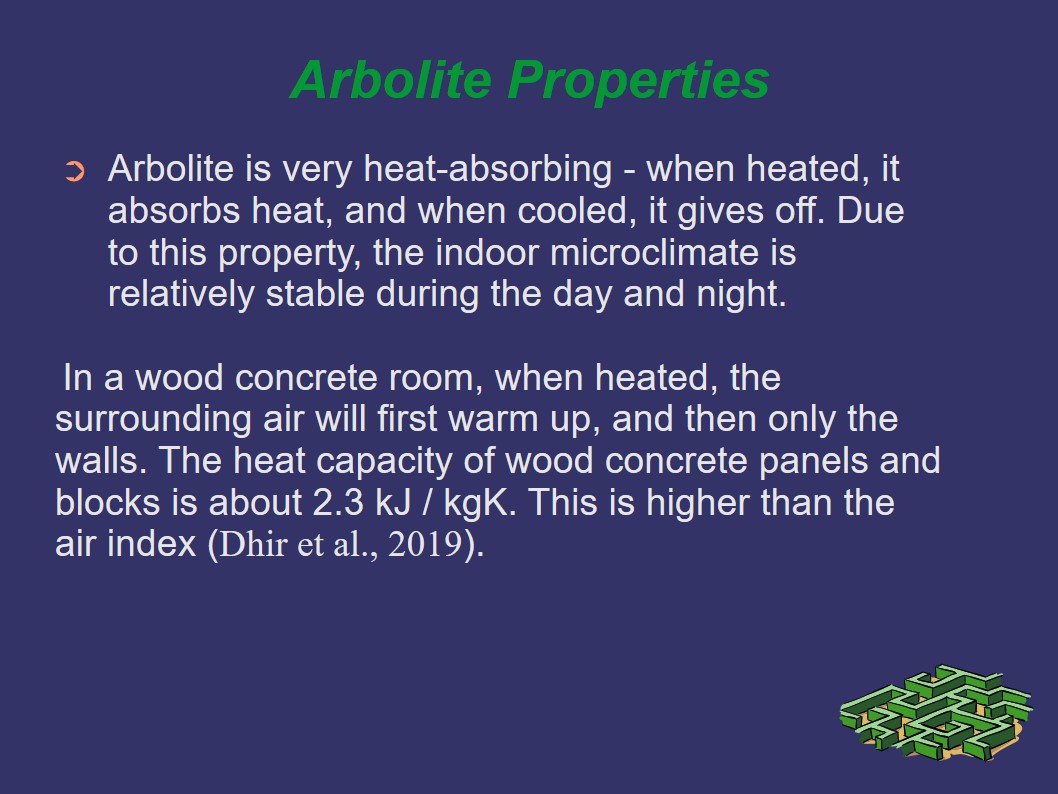
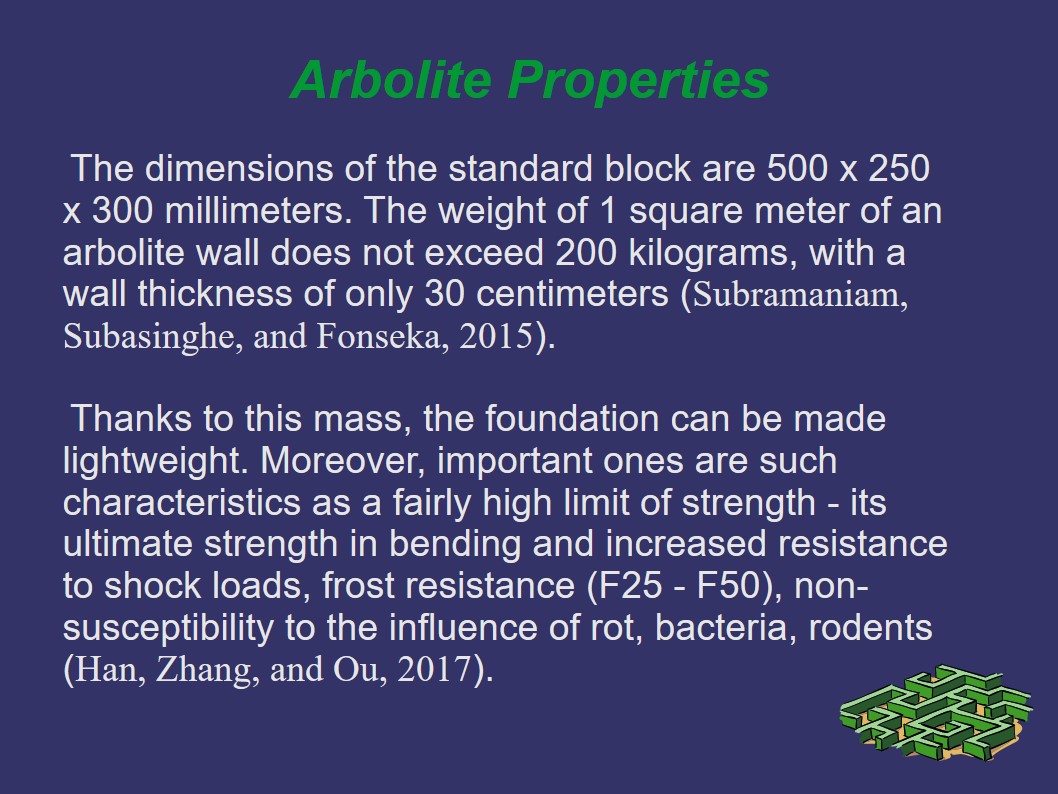
Arbolite Overall Benefits
The cost of a wall made of wood concrete is cheaper than haydite concrete slab and bricks insulated with mineral wool, more than 2 times.
In addition, the costs of building the foundation are significantly reduced, because the weight of the wood concrete is much less than the brickwork. The cost of a house is almost 2-3 times lower than that of a brick (Sabnis, 2015).
The interest in wood concrete has increased especially in the last five years (Subramaniam, Subasinghe, and Fonseka, 2015). This is facilitated by the increasing demands on housing in terms of ecology, energy efficiency and fire safety. As for environmental friendliness, it is easy to breathe in wood concrete houses, and the vapor permeability is such that the air is constantly renewed in the room.
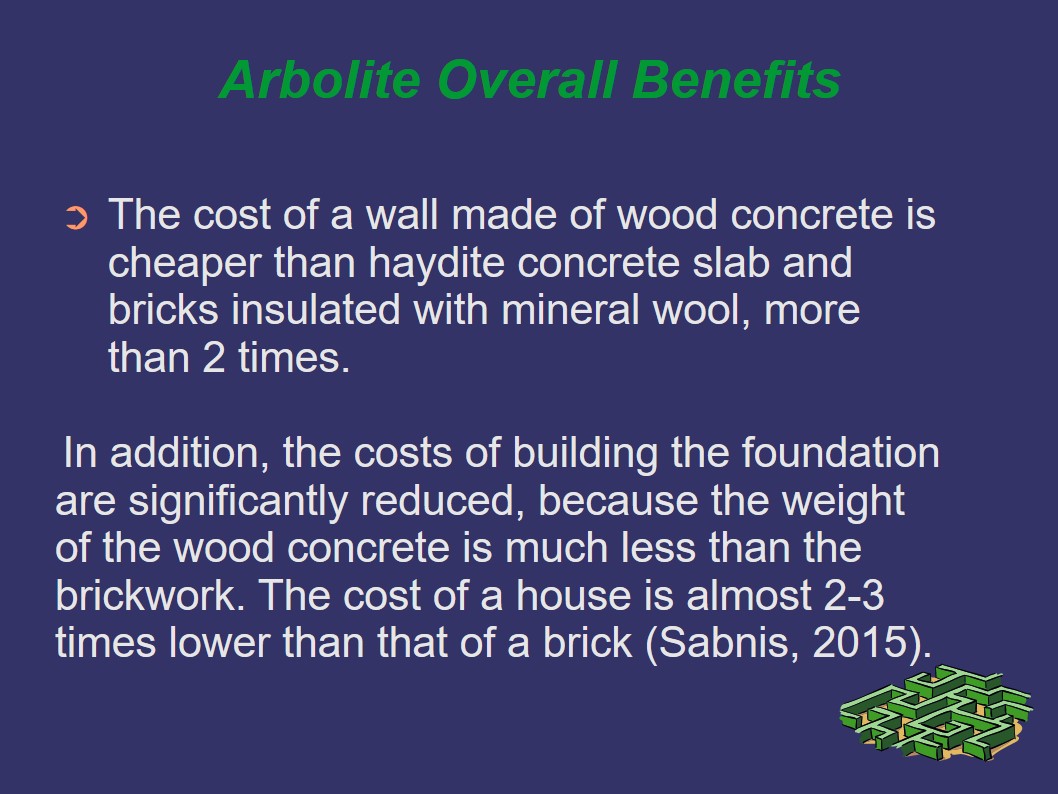
Conclusion
- Arbolite blocks are used in both industrial and civil construction for:
- strengthening the walls.
- erection of supporting structures.
- thermal insulation of buildings and structures.
- When using wood concrete, one will receive the following undeniable benefits:
- Reduce the cost of building a house by optimizing financial and energy costs.
- Reduce the construction time of the building significantly.
- Reduce the total mass of the building.
- Improve the quality of life with sustainable building materials.
Thus, using arbolite provides sound economic, ecological, and social benefits.
Any finishing material easily falls on the wood concrete. All these properties of arbolite make it one of the most popular building materials.
Arbolite buildings were erected even in the extremely harsh conditions of Antarctica.
In multi-storey buildings, arbolite can be used as filling openings, with a monolithic reinforced concrete frame of the building.
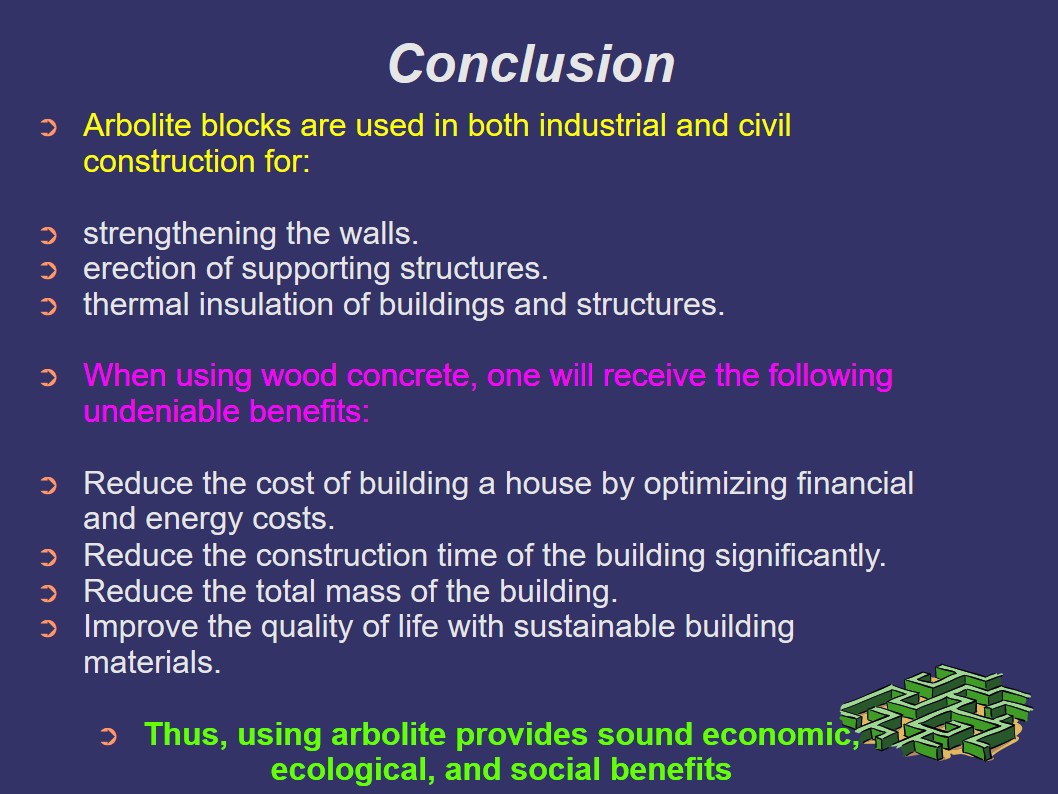
References
Aruova, L. (2018) ‘Manufacturing arbolitic building products using solar energy,’ Journal of Mechanical Engineering Research and Developments, 41(2), pp. 49-55.
De Luca, P., Carbone, I., and Nagy, J. (2017) ‘Green building materials: A review of state of the art studies of innovative materials,’ Journal of Green Building, 12(4), pp. 141-161.
Dhir, R. K. et al. (2019) Sustainable construction materials: recycled aggregates. Cambridge: Woodhead Publishing.
Dykstra, A. (2016) Green construction: an introduction to a changing industry. London: Kirshner Books.
Han B., Zhang L. and Ou J. (2017) Light-Emitting Concrete. Smart and Multifunctional Concrete Toward Sustainable Infrastructures. New York: Springer.
Kibert, C. (2016) Sustainable construction: green building design and delivery. Hoboken: Wiley.
Magwood, C. (2017) Essential sustainable home design: a complete guide to goals, options, and the design process. Gabriola Island: New Society Publishers.
Sabnis, G. (2015) Green building with concrete: sustainable design and construction. Boca Raton: CRC Press.
Subramaniam, P., Subasinghe, K. and Fonseka, K. (2015). ‘Wood ash as an effective raw material for concrete blocks,’ International Journal of Research in Engineering and Technology, 04(02), pp. 228-233.
Yilmaz, M. and Bakis, A. (2015) ‘Sustainability in construction sector,’ Procedia – Social and Behavioral Sciences, 195, pp. 2253-2262.
Zwicky, D. (2015) Mechanical properties of wood-cement compounds. Conference: 10th Conference on Advanced Building Skins At: Berne, Switzerland.